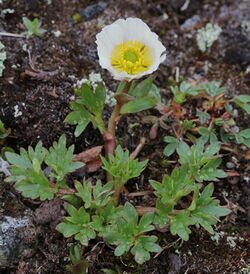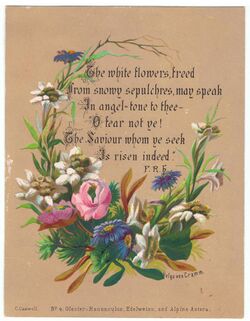Biology:Ranunculus glacialis
| Ranunculus glacialis | |
|---|---|

| |
| Scientific classification | |
| Kingdom: | Plantae |
| Clade: | Tracheophytes |
| Clade: | Angiosperms |
| Clade: | Eudicots |
| Order: | Ranunculales |
| Family: | Ranunculaceae |
| Genus: | Ranunculus |
| Species: | R. glacialis
|
| Binomial name | |
| Ranunculus glacialis | |
| Synonyms | |
| |
Ranunculus glacialis, the glacier buttercup[1] or glacier crowfoot, is a plant of the family Ranunculaceae. It is a 5-10(-20) cm high perennial herb. Often with a single relatively large (1.8 - 3.8 cm) flower, with 5 petals first white later pink or reddish. The underside of the 5 sepals are densely brown-hairy. The leaves are fleshy, shiny, and deeply loped, forming 3 leaflets.[2][3] Ranunculus glacialis reported (from Greenland material) to have a diploid chromosome number of 2n = 16.[2]
Distribution and habitat
Ranunculus glacialis is an Arctic–alpine species, found in the high mountains of southern Europe (Alps, Pyrenees, Carpathians, Sierra Nevada) as well as on the Scandinavian peninsula, Iceland, the Faroe Islands, Jan Mayen, Svalbard, eastern Greenland[4][5] and Finland , where is endangered and protected.[6]
It has been described as being one of the highest-ascending plant in the Alps, flowering at over 4,000 m.[7]
It is found in fell-field and snow-bed sites, on edges of meltwater streams.[6]
Subspecies
Several subspecies are described.[8]
One subspecies, Ranunculus glacialis subsp. chamissonis, is found on either side of the Bering Strait in Siberia, Russia and Alaska, U.S..
Further reading

- Totland, Ø., & Alatalo, J. M. (2002). Effects of temperature and date of snowmelt on growth, reproduction, and flowering phenology in the arctic/alpine herb, Ranunculus glacialis. Oecologia, 133(2), 168–175. https://doi.org/10.1007/s00442-002-1028-z
- Wagner, J., Steinacher, G., & Ladinig, U. (2010). Ranunculus glacialis L.: successful reproduction at the altitudinal limits of higher plant life. Protoplasma, 243(1-4), 117–128. https://doi.org/10.1007/s00709-009-0104-1
References
| Wikimedia Commons has media related to Ranunculus glacialis. |
- ↑ 1.0 1.1 "Ranunculus glacialis". Natural Resources Conservation Service PLANTS Database. USDA. https://plants.usda.gov/core/profile?symbol=RAGL2. Retrieved September 10, 2013.
- ↑ 2.0 2.1 Grønlands flora. Tyge Wittrock Böcher (3. reviderede udgave ed.). København: P. Haase & Sons. 1978. ISBN 87-559-0385-1. OCLC 183098604. https://www.worldcat.org/oclc/183098604.
- ↑ Nordens flora. Bo Mossberg, Lennart Stenberg, Jon Feilberg, Anna Torsteinsrud, Victoria Widmark (Nye, udvidede og omarbejdede udgave ed.). Kbh.: Gyldendal. 2020. ISBN 978-87-02-28916-9. OCLC 1158895781. https://www.worldcat.org/oclc/1158895781.
- ↑ "Pan-arctic flora: Home". http://panarcticflora.org/results?biogeographic=&bioclimatic=®ion=&name=ranunculus+glacialis#paf-361201.
- ↑ "Ranunculus glacialis L." (in en). https://www.gbif.org/species/3033461.
- ↑ 6.0 6.1 "Glacier Buttercup, Ranunculus glacialis - Flowers - NatureGate". https://luontoportti.com/en/t/2323/glacier-buttercup.
- ↑ Wagner, Johanna; Steinacher, Gerlinde; Ladinig, Ursula (July 2010). "Ranunculus glacialis L.: successful reproduction at the altitudinal limits of higher plant life" (in en). Protoplasma 243 (1–4): 117–128. doi:10.1007/s00709-009-0104-1. ISSN 0033-183X. PMID 20140466. http://link.springer.com/10.1007/s00709-009-0104-1.
- ↑ "International Plant Names Index". https://www.ipni.org/?q=ranunculus%20glacialis.
Wikidata ☰ Q161508 entry
ru:Беквичия ледниковая#Название
 |

